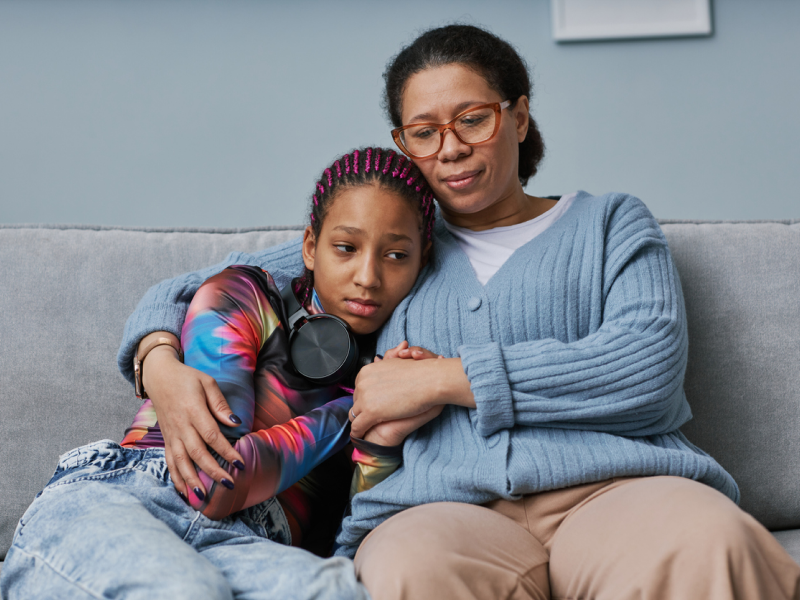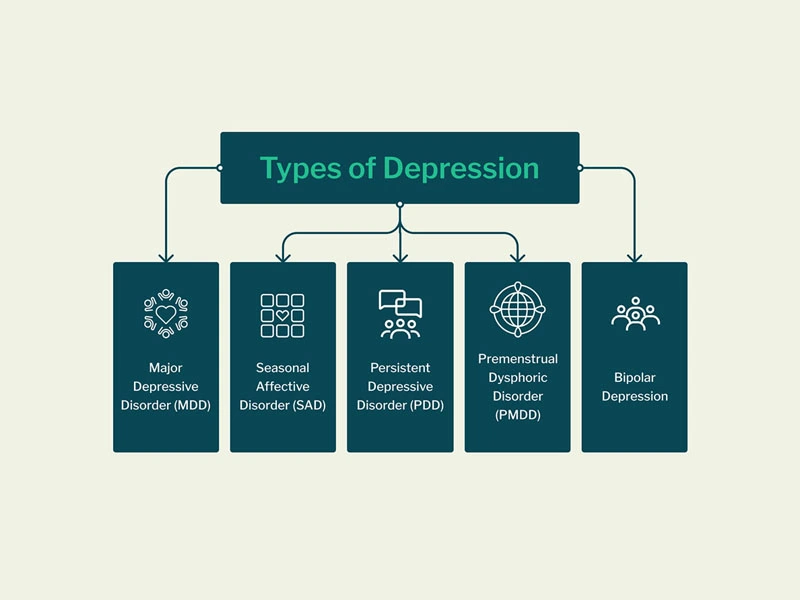
Table of Contents
5 Depressive Disorders in Teens and Young Adults

Written By: Alex Bachert, MPH
April 18, 2022
5 min.
Learn more about the five major types of depression and how they can show up in teens.
Learn more about our Clinical Review Process
Table of Contents
Have you ever thought to yourself that you or someone in your life might be struggling with depression, but you weren’t sure if what you felt or observed “checked all the boxes?” Or maybe you weren’t even sure what those boxes were. If so, it’s completely understandable because depression is complex…sort of like each of us.
According to Mental Health America, depressive disorders are a category of mood disorders defined by extended periods of feeling low that are severe enough to interfere with a person’s ability to enjoy life. Although common in the United States, depressive disorders aren’t one-size-fits-all, which can make them difficult to navigate. There are multiple types of depression, and each presents its own unique causes, symptoms, and levels of acuity.
Despite their differences, however, there is one thing all types of depression have in common. Any form of depression is a serious mental health condition that can affect a person’s quality of life in both the short term and the long term. And although depression is treatable with access to treatments such as intensive outpatient therapy and medication, many teens and young adults living with depression don’t receive the necessary resources.
The fact that you’re reading this article is a positive step in the right direction for helping you or a loved one to combat depression. Read on to learn about five of the most common types of depressive disorders among teens and young adults in the United States, as well as how to connect with care.

Major depressive disorder (MDD)
Also known as clinical depression, major depression is one of the most common mental health disorders in the United States, affecting nearly eight percent of U.S. adults, according to a 2020 report from the National Institutes of Mental Health. Among adults who experienced a major depressive episode, the prevalence was highest among young adults aged 18-25 years. MDD also affected 17%—or 4.1 million—of adolescents aged 12 to 17 years.
Further research shows that major depressive disorder in children and adolescents often goes underdiagnosed and undertreated, which can have consequences on academic performance and social functioning, as well as an increased risk of suicidal behaviors.
Major depression looks different for different people, but by definition it causes overwhelming symptoms that interfere with how you feel, function, and live your everyday life. To be officially diagnosed with major depression, you must have five or more of the following symptoms on most days for at least two weeks.
- Persistent sad or anxious mood
- Irritability
- Loss of interest in hobbies and activities
- Feelings of hopelessness
- Feelings of guilt, worthlessness, or helplessness
- Feelings of restlessness
- Fatigue
- Moving or talking slowly
- Difficulty concentrating, remembering, or making decisions
- Difficulty sleeping
- Changes in appetite or weight changes
- Suicidal thoughts
This may read like a long list, but again, not everyone will experience all of these symptoms.
Persistent depressive disorder (PDD)
Depression that lasts for longer than one year in teenagers (and longer than two years in adults) is considered to be persistent depressive disorder, or dysthymia. PDD tends to be more mild than major depression, but it can have serious consequences on a teenager or young adult’s life if not addressed and treated.
So, what should you look for? An individual living with PDD might be frequently irritable and show signs of low self-esteem, fatigue, difficulty making decisions, or feelings of hopelessness. You might also notice a change in their eating and sleeping habits.
The biggest indicator that someone might be experiencing PDD is that their symptoms last for most of the day, on most days, and over an extended period of time.
Do you need more support with
your mental health?
Charlie Health can help.
Bipolar depression
Bipolar is a mental health disorder characterized by mood swings ranging from depressive lows to manic highs. There are three different bipolar diagnoses—bipolar I, bipolar II, and cyclothymic disorder—and each includes a low period where individuals will experience symptoms of depression, such as sadness, hopelessness, or lack of energy.
Most individuals with bipolar disease will first experience symptoms around age 25, but they can also begin during the teen years. What’s more, many will go 6-8 years after onset symptoms before receiving a diagnosis or treatment, with the delay even longer among juveniles.
In addition to experiencing symptoms of depression, individuals with bipolar depression are at an increased risk for other medical conditions. Compared with the general population or even those with other psychiatric disorders, they’re more likely to develop diabetes, cardiovascular disease, and even suicidal behaviors.
Premenstrual dysphoric disorder (PMDD)
Premenstrual dysphoric disorder is a severe form of premenstrual disorder (PMS) that affects women in the days and weeks prior to their menstrual period. While mood swings and irritability are hallmarks of PMS, PMDD is different and more extreme.
Up to 40 percent of women may experience some degree of PMS, with an estimated 3-5 percent classified as premenstrual dysphoric disorder. PMDD causes severe anxiety, depression, and sometimes suicidal thoughts, and symptoms are often distressing enough to interfere with how an individual functions at work, home, sexually, and in relationships.
For most women, the symptoms present six days before their menstrual period begins then usually go away two or three days into their period. Symptoms need to occur for two consecutive menstrual cycles in order to warrant a PMDD diagnosis.
Seasonal affective disorder (SAD)
Seasonal affective disorder is a type of depression that typically begins in the fall and improves during spring and summer. While it’s normal for your mood to fluctuate as the seasons change, SAD is a form of recurrent depression that affects everything from appetite to sleep to energy levels.
SAD tends to start in young adulthood, with approximately five percent of adults in the United States having experienced the condition. Interestingly, about 75 percent of those affected by SAD are women. Symptoms usually last 4-5 months and are similar to those associated with major depression, according to the National Institute of Mental Health.
For winter-pattern SAD, specific symptoms to look out for include:
- Oversleeping
- Overeating
- Weight gain
- Social withdrawal
Although much less common, some people may experience depressive episodes during the spring and summer months, also known as summer-pattern SAD. Symptoms can include:
- Trouble sleeping
- Poor appetite and weight loss
- Restlessness and agitation
- Anxiety
- Violent behavior
How Charlie Health can help with teen depressive disorders
Depression can be extremely overwhelming—both for individuals living with the symptoms and their family and friends. Recognizing the signs of major depressive disorder or its subtypes is the first step in understanding how to cope. Taking that initial step can feel daunting, but seeking support will make life so much brighter.
At Charlie Health, we offer high-quality mental healthcare for adolescents, young adults, and their family members. If you or someone you know is struggling with depression, our compassionate mental health professionals are here to answer your questions, explore treatment options, and help build strategies to prioritize mental health.
References
- https://www.mhanational.org/conditions/depression
- https://www.charliehealth.com/post/iop-for-depression-how-intensive-outpatient-programs-treat-depression
- https://www.nimh.nih.gov/health/statistics/major-depression
- https://www.ncbi.nlm.nih.gov/pmc/articles/PMC6213890/
- https://www.nimh.nih.gov/health/topics/depression
- https://www.psychiatry.org/patients-families/bipolar-disorders/what-are-bipolar-disorders
- https://journalbipolardisorders.springeropen.com/articles/10.1186/s40345-019-0160-1
- https://www.ncbi.nlm.nih.gov/books/NBK279045/
- https://www.charliehealth.com/post/what-is-seasonal-affective-disorder
- https://pubmed.ncbi.nlm.nih.gov/33252911/
- https://www.nimh.nih.gov/health/publications/seasonal-affective-disorder





